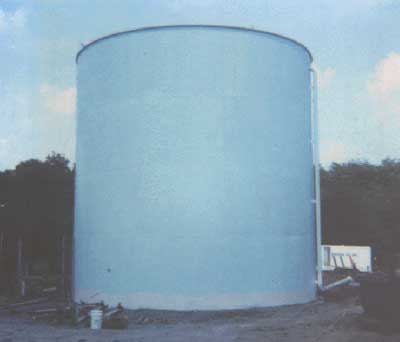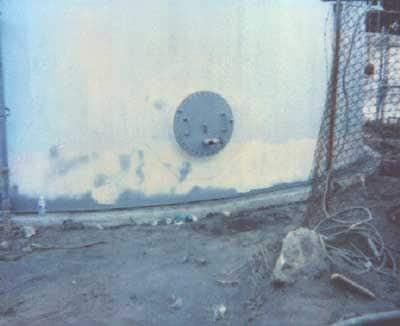Two Laborers Die From a Scaffolding Fall Inside a Water Tank
Kentucky Case Report: 02KY041
Date of Incident: June 19, 2002
Report Release Date: March 11, 2003
Summary
Two 20 year-old laborers died after falling approximately 25 feet from suspension scaffolding while preparing the inside of a municipal water tank for painting. Neither laborer was wearing fall personal protection equipment at the time of the fatal incident. The laborers were preparing the inside of a 200,000-gallon water tank for painting when one end of the scaffolding dropped after a support cable slipped. The job foreman arrived at the job site and entered the tank to check on the laborers. He found both laborers on the tank floor. Laborer 1 had respiratory vital signs but Laborer 2 did not. The foreman left the tank, called 911 then reentered the tank. Emergency medical services arrived at the scene and administered cardio pulminary rescitation to the laborers. Laborer 2 was declared dead at the scene. Laborer 1 died the next day in the hospital.
To prevent similar incidents from occurring, Kentucky FACE recommends:
- Scaffolding should be inspected for safety hazards prior to each work shift and every time it is moved.
- Employees should use fall personal protection equipment provided by the employer.
- Safety training and warnings should be reinforced regularly to employees exposed to the dangers of falls from heights.
Introduction and Background
On June 19, 2002, through a radio news program, The Kentucky FACE program became aware of an incident involving an occupational fatality and a severely injured co-worker. A site visit was made with the local coroner on Friday, June 21, 2002. A second site visit was made the following Monday, June 24, 2002, with the coroner and a Kentucky Occupational Safety and Health Compliance Officer who was investigating the fatal incident. Also attending were the company attorney, four employees, the medical examiner and his assistant.
The company had agreed to contract with a municipality to clean, repair and paint a 32-foot high, 200,000-gallon water tank that had been built in 1975. The tank had previously been drained and the water input valve to the tank was closed and locked out to prevent water from entering the drained tank. This particular job entailed scraping, sanding, patching and painting the inside and outside of the tank. There was a 24-inch manhole access / egress on the side at the bottom of the tank and another in the top of the tank. Electrical power to the work site to run drills, sanders, sand blasters, and lights and motors for the motorized scaffolds was provided by an 8,000-watt generator. Scaffolding used by the laborers inside the tank was purchased from an outside source.
This work crew consisted of a foreman and three laborers. The crew had been working on the tank for approximately four weeks and the job was near completion when the incident occurred. Both laborers had been employed by the company for approximately two years. Prior to working for the company, the two men had housed tobacco and were used to working in the high rafters of barns high off the ground.
The company had a safety program and conducted regular routine safety meetings weekly. Employees were trained on the assembly and erection of scaffolding. The foreman was responsible for ensuring safety compliance including employees and equipment. Fall protection was provided by the company.
Investigation
On the day before the incident, the two laborers had disassembled the motorized, suspended scaffolding they were using and moved it to a different location inside the tank. The two laborers then reassembled the scaffolding, suspended it by cables and anchored it to the top outside of the tank. The base of the scaffolding was 16’9″ in length and 20″ wide and had metal boards. The railing stanchions measured 44″ high. Two side railings were clamped to the stanchions and ran the length of the base. One railing was 22.5″ above the base; the other 40″ above the base, and were 18″ apart. After reassembly of the scaffolding was complete, the laborers informed the foreman the scaffolding was ready for the next day.
The two laborers, another laborer and the foreman arrived the next morning before 7:00 AM. One laborer was to work on the outside of the tank. Wearing earplugs, a helmet and a facemask, he began to sand blast the outside of the tank. The two 20-year-olds entered the water tank unsupervised sometime between 7:00 AM to 7:15 AM. Their job was to continue preparing the inside of the tank for painting. At the same time, the foreman left the job site to return some equipment to a nearby town.
Upon the foreman’s return to the work site at approximately 7:55 AM, he entered the tank to check on the progress of the two laborers inside the water tank. Upon re-entering the tank through the manhole at the base of the tank, he was met with a cloud of dust. The foreman exited the tank and told the other laborer to turn off his equipment. The foreman then retrieved a flashlight and reentered the tank. Upon entering the water tank, he discovered both men on the floor of the tank. The foreman checked both men for pulses. Laborer 2 had no pulse and Laborer 1 was moaning. He exited the water tank again and called 911 emergency services from his cell phone, then reentered the tank. The foreman began administering CPR to the laborer with no pulse. The 911 call was received at the state police post at 7:55 AM. Emergency medical service including an ambulance, the volunteer fire department, the local rescue squad, a detective and a state trooper were dispatched. The state trooper and detective both arrived at 8:10 AM and 8:17 respectively. The ambulance and rescue squad arrived between 8:00 AM – 8:10 AM. Rescue personnel entered the tank and administered emergency medical care to both laborers. Emergency medical personnel stabilized Laborer 1 before he was taken by ambulance to a nearby field where a helicopter airlifted him to a nearby hospital. The coroner was contacted. He arrived at 8:40 AM and declared Laborer 2 dead at the scene. Laborer 1 was subsequently airlifted to another hospital where he died the following day.
Upon investigation and reconstruction of the incident by Kentucky Labor Cabinet’s Division of Occupational Safety and Health and the medical examiner, a piece of the anchoring mechanism, which secured the scaffolding, was discovered to be missing. The missing piece was not found at the site. In addition, neither laborer was wearing personal fall protection equipment at the time of the fatal incident. The personal fall protective equipment (body harness) was located in the toolbox onsite.
Cause of Death
The death certificates indicated that the cause of death was traumatic brain injury for both decedents.
Recommendations and Discussion
Recommendation No. 1: Scaffolding should be inspected for safety hazards prior to each work shift and every time the scaffolding is moved.
Currently the Occupational Safety and Health Act 1926.451(f)(7) requires scaffolding to be inspected by a competent person prior to use after it is erected or has been modified. After the initial inspection, the scaffolding can be used without further inspection until it is modified. The scaffolding had not been inspected after it had been moved or the morning of the day of the fatal incident by a competent person.
Recommendation No. 2: Employees should use fall personal protection equipment provided by the employer.
Employees have a responsibility to ensure their work area is safe and to use safety equipment provided by the company. This is part of the General Duty clause 29CFR1910 in OSHA General Industry Regulations. Employers should continually stress the need for workers to wear required personal protection equipment.
Recommendation No. 3: Safety training and warnings should be reinforced regularly to employees exposed to the dangers of falls from heights.
The two laborers involved in this incident were accustomed to working at high heights and may have been inured to the inherent dangers. Employers should provide regular reinforced safety training when dealing with highly hazardous work situations and strictly enforce safety regulations and practices.
References
- U.S. Department of Labor, Occupational Safety & Health Administration, Construction eTool, Scaffolding, https://www.osha.gov/SLTC/etools/scaffolding/suspended/twopoint/anchorage.htmlexternal icon
- 29 CFR 1910 OSHA General Industry Regulations, Mangan Communications, Inc., General Duty Clause 5(b), p 69
Photographs

|
 |
| Picture of access / egress portal to water tank. The diameter of the access / egress is 24 inches and is 21 inches from the top of the concrete base, which is 5 inches deep. |
Kentucky FACE Program
The Kentucky Fatality Assessment & Control Evaluation Program (FACE) is funded by a grant from the Centers for Disease Control and the National Institute of Safety and Health. FACE’s purpose is to aid in the research and prevention of occupational fatalities by evaluating events leading to, during, and after a work related fatality. Recommendations are made to aid employers and employees to have a safer work< environment. Current focuses of the program are occupational fatalities involving: construction, machinery, migrant workers (particularly Hispanics) and youth.
To contact Kentucky State FACE program personnel regarding State-based FACE reports, please use information listed on the Contact Sheet on the NIOSH FACE web site Please contact In-house FACE program personnel regarding In-house FACE reports and to gain assistance when State-FACE program personnel cannot be reached.

